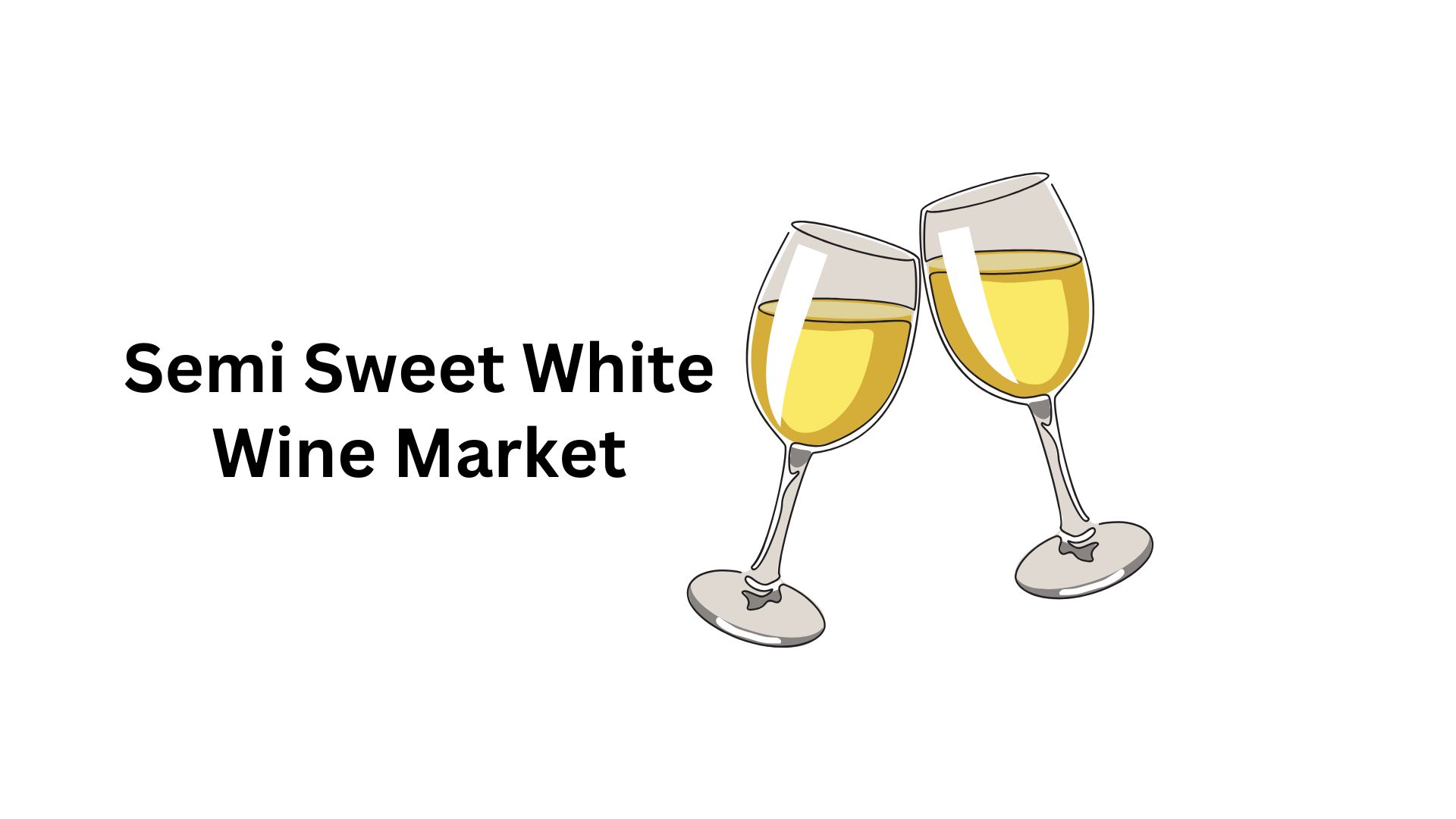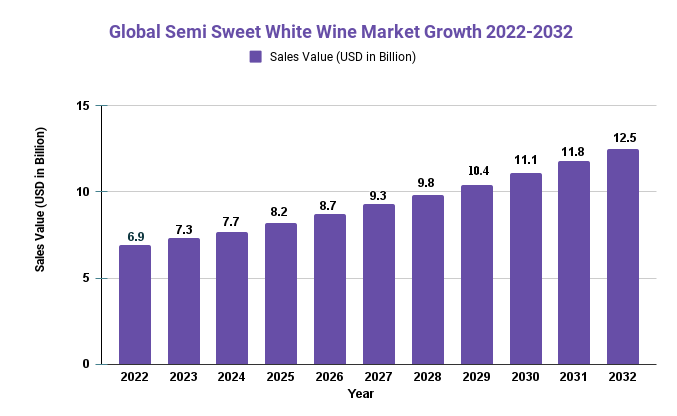Semi Sweet White Wine Market Size Worth USD 12.5 Bn by 2032

Page Contents
Market Overview
Published Via 11Press: The Semi-Sweet White Wine Market is a segment within the wine industry that appeals to those who prefer not too dry or sweet wines. Made from various grape types, semi-sweet white wines have a fruity and refreshing taste that appeals to many palates.
The global semi sweet white wine market is projected to reach USD 12.55 Bn by 2032, up from the estimated value of 6.9 Bn in 2022 – growing at an annual compound growth rate (CAGR) of 6.2% from 2023-2032.
The growth is attributed to factors such as an increasing consumer preference for sweeter and fruitier wines, rising demand for wines with lower alcohol content, and growing use of wine during social gatherings and celebrations.
The market for semi-sweet white wines is dominated by several major players, such as E&J Gallo Winery, Constellation Brands, Treasury Wine Estates, and Accolade Wines. These companies boast a significant global presence with an extensive range of wines available to suit different consumer preferences and tastes.
Distribution channels: Retail stores such as supermarkets and liquor stores remain dominant in the market. However, online purchasing of wine has seen an uptick in popularity due to its convenience and ease. E-commerce platforms like Amazon, Wine.com, and Vivino have become particularly popular during the COVID-19 pandemic as they provide a secure way for people to purchase wine from home without leaving their homes.

Drivers, trends, and challenges have an impact on market dynamics, which can impact businesses. Request for PDF sample report
Key Takeaways
- The semi sweet white wine market is expected to experience steady growth over the coming years, due to increased consumer interest in sweet and light wines.
- Consumer preference has shifted towards wines with lower alcohol content, leading to the popularity of semi-sweet white wines.
- The COVID-19 pandemic has had a dramatic effect on the market, resulting in an uptick in online wine sales and home consumption due to lockdowns and restrictions placed on dining out.
Regional Snapshot
- Europe is the leading market for semi-sweet white wine, with countries like Germany, France, and Italy dominating. This can be attributed to the longstanding traditions of wine consumption in these nations.
- North America is a major market for semi-sweet white wine, with the United States playing an especially significant role in driving growth within this region.
- Asia Pacific is expected to experience the fastest growth in this market, due to increasing wine consumption in countries like China, Japan, and India.
- Latin America and the Middle East/Africa are also becoming increasingly attractive markets for semi-sweet white wine due to growing consumer interest in these regions and an uptick in wine production.
Drivers
- Consumer preference for sweet and light wines, particularly among younger consumers, is fueling demand for semi-sweet white wine.
- Furthermore, the trend towards lower alcohol content in wines is contributing to its growing popularity.
- Semisweet white wine is becoming more accessible and available through retail channels and online platforms, giving customers more choices and accessibility. Furthermore, growing interest in wine culture and tourism is fuelling demand for this variety of wine in regions renowned for their production.
Restraints
- High competition from other wine types, such as red and dry white wine, could limit market growth for semi-sweet white wine.
- Additionally, concerns over excessive sugar consumption could potentially limit demand in this segment.
- Global economic conditions and shifting consumer preferences can influence the sales and growth of the semi-sweet white wine market.
- Furthermore, stringent government regulations related to wine production and marketing could further constrain this sector's expansion.
Opportunities
- Semi-sweet white wine has seen an uptick in popularity among health-conscious consumers who desire lower alcohol and sugar content in their beverages.
- There has also been an explosion of interest in wine culture and tourism within emerging markets, potentially creating new sales opportunities for producers of this variety of wine.
- Expanding online sales channels and direct-to-consumer models can help reach a wider audience and boost sales.
- The rise of organic and sustainable wine production methods presents opportunities for those producing semi-sweet white wines who adopt these practices.
Challenges
- Competition from other wine types and non-alcoholic beverages can pose a challenge to the growth of the semi sweet white wine market.
- Additionally, wine production is complex and time-consuming which limits the scalability of smaller producers.
- Price sensitivity among customers can be a hurdle for premium-priced semi-sweet white wine products.
- Concerns over the environmental impact of production – such as water usage and greenhouse gas emissions – could limit growth opportunities in this market.
Recent Developments
- In 2020, Barefoot Wine released their Barefoot Sweet Symphony semi-sweet white wine which quickly gained traction among consumers.
- In 2013, Beringer released their Main & Vine line of semi-sweet wines to appeal to millennials looking for more approachable and easy-to-drink wines.
- The COVID-19 pandemic has seen an uptick in online wine sales, with many wineries and retailers providing virtual tastings and direct-to-consumer shipping options for semi-sweet white wine.
Key Market Segments
Type
- Still Wines
- Sparkling Wines
Application
- Daily Meals
- Social Occasions
- Entertainment Venues
- Other Situations
Key Market Players
- E&J Gallo Winery
- Constellation
- Castel
- The Wine Group
- Accolade Wines
- Concha y Toro
- Treasury Wine Estates (TWE)
- Trinchero Family
- Pernod-Ricard
- Diageo
- Casella Wines
- Changyu Group
- Kendall-Jackson Vineyard Estates
- Great Wall
- Dynasty
Report Scope
| Report Attribute | Details |
| The market size value in 2022 | USD 6.9 Bn |
| Revenue forecast by 2032 | USD 12.5 Bn |
| Growth Rate | CAGR Of 6.2% |
| Regions Covered | North America, Europe, Asia Pacific, Latin America, and Middle East & Africa, and Rest of the World |
| Historical Years | 2017-2022 |
| Base Year | 2022 |
| Estimated Year | 2023 |
| Short-Term Projection Year | 2028 |
| Long-Term Projected Year | 2032 |
Frequently Asked Questions
Q: What food pairings go well with semi-sweet white wine?
A: Semi-sweet white wine pairs well with a variety of foods, including spicy dishes, Asian cuisine, and desserts like fruit tarts and cakes.
Q: Is semi-sweet white wine suitable for aging?
A: Semi-sweet white wine is generally not suitable for aging, as it is meant to be consumed while it is still young and fresh.
Q: What is the ideal serving temperature for semi-sweet white wine?
A: The ideal serving temperature for semi-sweet white wine is typically between 45 and 55 degrees Fahrenheit (7 and 13 degrees Celsius).
Q: How many calories are in a glass of semi-sweet white wine?
A: The number of calories in a glass of semi-sweet white wine can vary depending on the brand and the size of the glass, but on average, a 5-ounce (150-milliliter) serving contains around 120-140 calories.
Q: What are some popular brands of semi-sweet white wine?
A: Some popular brands of semi-sweet white wine include Barefoot Sweet Symphony, Beringer Main & Vine, and Chateau Ste. Michelle Riesling, and Yellow Tail Sweet White Roo.
The team behind market.us, marketresearch.biz, market.biz and more. Our purpose is to keep our customers ahead of the game with regard to the markets. They may fluctuate up or down, but we will help you to stay ahead of the curve in these market fluctuations. Our consistent growth and ability to deliver in-depth analyses and market insight has engaged genuine market players. They have faith in us to offer the data and information they require to make balanced and decisive marketing decisions.



